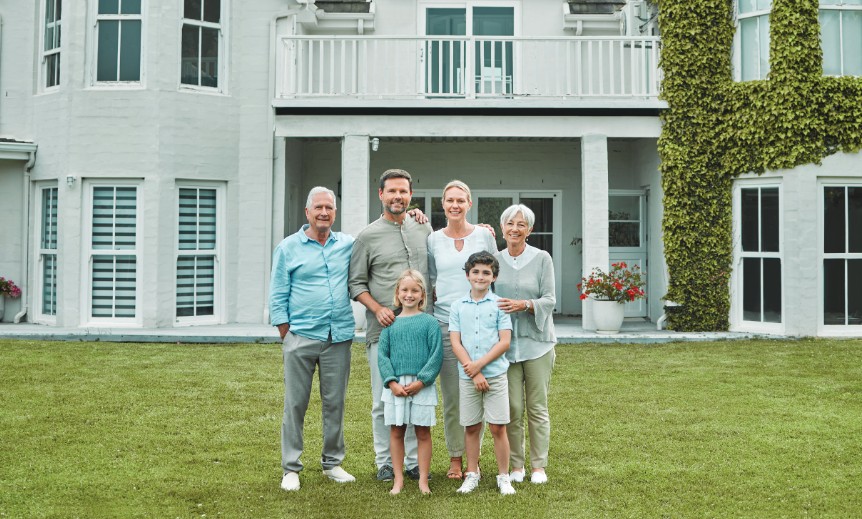by Dan Lalande
Before the post-war housing boom, it was not uncommon to find three generations living together under a single roof. While that arrangement had its drawbacks, today, sociologists generally agree that this forsaken model created closer families and a more inclusive society. We’ve been growing apart as bloodlines and communities ever since.

But multigenerational cohabitation is making a comeback, spawned by the seemingly unsolvable housing shortage and the ever-rising cost of living.
While many immigrant families have successfully imported this model, native-born North Americans have been slow to follow their example—until now. According to a recent Statistics Canada inventory, the number of properties shared by multiple generations, two or more families, or one family living with unrelated tenants has grown by 45 percent over the past 20 years, a total of almost one million homes. All levels of government are accommodating the renovation of existing homes or the establishment of new ones on existing properties. There’s even a federally funded tax rebate for qualifying families.
While the social aspect of this style of living is its main recommendation, there are myriad others. Major expenses, including mortgages, utilities and food, can be proportionately shared; cleaning and other household chores can be divided equitably; and cost-free childcare and/or eldercare is readily available within the home.
This is not to say that it doesn’t have its drawbacks. Privacy can become an issue, as can more practical matters like adequate parking. But with architectural foresight and well-policed ground rules, the arrangement can prove a veritable godsend.
It’s also a boon to Canada’s frustrated disability community, particularly parents faced with the paucity of choices for independent or semi-independent living for their adult children, who are stuck on long waitlists for the few available public options.
There are several popular models under the banner of multi-generational housing, each with its own legal considerations. The most popular are second units, coach houses and age-in-place and adaptiv living renovations.
Second Units
A second unit, also known as a “secondary dwelling,” is a self-contained residence—with its own kitchen, bath and sleeping areas—located within the primary dwelling. These definitions encompass a wide variety of living arrangements, including converted garages, basement or above-basement apartments, in-law suites and laneway units. They’re often built to create rental income and/or to increase the value of the hosting home, but they can also facilitate intergenerational living. Be warned, though: the Ontario Building Code’s rules on the location of these units within a household vary. For this reason, it’s important to consult with your local municipal planning and building department before you do anything, as they can keep you up to date on zoning, permits, design, and inspection requirements. This will ensure the safety of the unit and prevent any legal issues in the future.
Coach Houses
A coach house is a separate dwelling located on the same lot as the principal dwelling, but that’s its own building. Water and sewage must be courtesy of connectivity to the primary home. Take note, however, that they’re called coach houses for a reason. They’re subject to strict size restrictions. A thorough investigation of local zoning by-laws should be conducted before construction. The addition of a coach house on your property could also result in an adjustment to your property and income taxes. It might also be prudent to notify your insurance company about your proposed project, not only to discuss liability concerns but also prospective adjustments to the value of your home.

Aging-In-Place and Adaptiv Home Renovations
Many companies offer home modifications for seniors with mobility issues, people with progressive conditions or individuals with disabilities. These designers and renovators are qualified specialists registered with the Canadian Home Builders’ Association. They work collaboratively with occupational therapists to custom design simple, effective modifications according to the needs of the client or tenant. The Qualified Adaptiv Home Specialists directory, listing companies offering these services, is at chba.ca/adaptiv-home.
Regardless of which approach you take, you’re likely eligible for the Multigenerational home renovation tax credit (MHRTC). Check the CRA website for complete details. You’ll find an eligibility checklist, information on shared renovation costs and examples of situations that may not qualify: canada.ca/en/revenue-agency/services/tax/individuals/topics/about-your-tax-return/tax-return/completing-a-tax-return/deductions-credits-expenses/multigenerational-home-renovation/eligible-mhrtc.html.
The above-listed options are a golden gateway to enhanced bonds, shared expenses, aging in comfort, and worry-free caregiving—issues that, for many families, are close to home.






